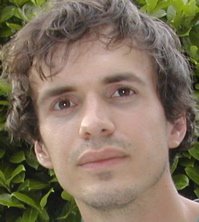After a week in Kyaingtong, the dusty road between Harry's Guesthouse and the Independence Monument seemed like a route I had walked for my entire life. There was the Shan Church and the stands selling noodle soup. There was the monastery where we played takraw every other day, the court marked out in the sand, the monks bumming cigarettes even though they're not supposed to. Due to the largesse of one of the monks, I ate my first insect a few days ago-- a large salty locust. My head still hurts from whacking the rattan ball with my head.
Further down the road there is a beautiful temple in the middle of a traffic roundabout. Like many of the wats, it is painted red and painted golden with decorations of Burmese dragons and the Buddha's life. Nearby, there is also the monstrous Kyaingtong New Hotel. The government knocked down a historical palace to build this hotel, and fortunately, it doesn't appear to be doing much business.
It's not much further down the street to a row of sewing shops and tea shops. The taxi drivers sit on their scooters and Burmese men watch violent American movies at the tea house next to the taxi stand. Across the street is one of our favorite places-- a sweets shop run by a Nepali couple with four kids. This was where we went for cold yogurt drinks, baked goods and rotis with curry.
Continue on the road and you reach the Independence Monument (how ironic), and further down, the marketplace. Turn right and you reach the lake and high on a hill above you see the Standing Buddha, which is lit at night. Our first evening here I almost mistook its face for the moon.
At ten pm this is what you see from a high place in town-- the stars, because there is no light pollution, the lit golden stupa at the town's center, the radio towers, the standing Buddha, the police station, perhaps the homes of a few affluent families with generators.
On three separate days we headed north out of town. We can't go south because there's a military checkpoint. For a week, we didn't have our passports, just a pink piece of cardboard with our pictures on it.
We can go north ten miles out of town and that's it. There are many dirt roads leading to the hills, the rice paddies, and tribal villages. On one day we went up to Dragon Hill where a rather eccentric hermit monk lives only on fruit, water and boxes of Lactasoy. There's an astouding view of the valley below.
If we were to walk a day further up that ridge, we would reach Wa territory and risk being shot.
From Dragon Hill you can see some of the villages in the woods below-- the Shan village, the Lahu village with its ancient looking church. Further up in the hills there are Akha villages. In one we were treated to bitter mushroom tea, fresh papaya and lumps of animal fat.
On our third day in town, we were walking to an Akha village just outside the Kyaingtong gates. There was a half-built temple surrounded by scaffolding, and a monk hailed us from the grounds. This man was the Venerable Nyanavara, and in the mornings we meditated with him and he taught us about the five precepts of Buddhism and other principles.
Our first three days in town we didn't see any other westerners. Altogether, we saw about a dozen westerners during our entire week.
Here's a little story about why we wanted to go to Kyaingtong. In Nan, I met a New Zealander named Rob who had just come back from Myanmar. Rob had also visited Luang Prabang ten years ago.
Nowadays, Luang Prabang is full of tourists. It's on the beaten path through Laos. Ten years ago, though, Rob sat in the back of a lorry with three other westerners to brave the rugged dirt road from Vientiane to Luang Prabang. There were two machine-gunners in the truck because of Hmong rebels in the hills.
He reached Luang Prabang and he was in awe of this ancient town (now a UNESCO site). It was, at that time, still untouched by the west.
Rob said that Kyaingtong gave him the same feeling that Luang Prabang gave him ten years ago. Now I have a sense of what he meant, and I feel both honored and very lucky to have spent the last week there.

